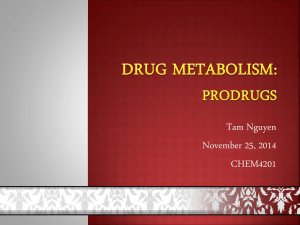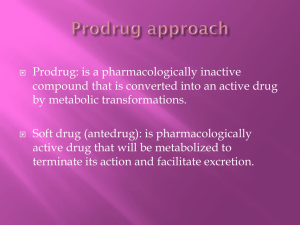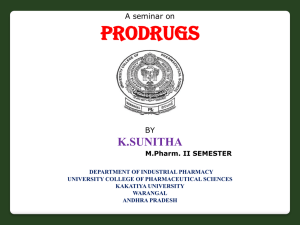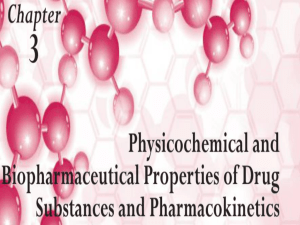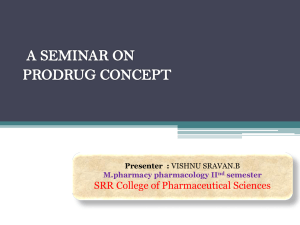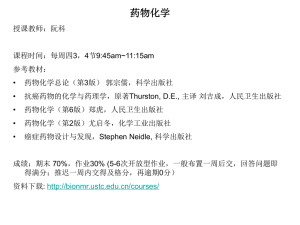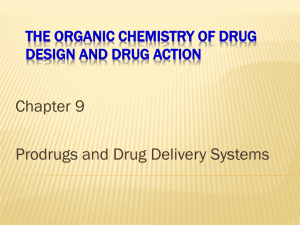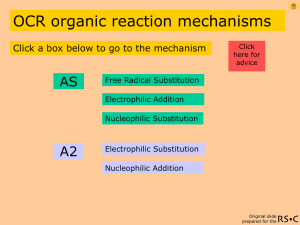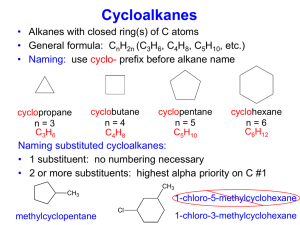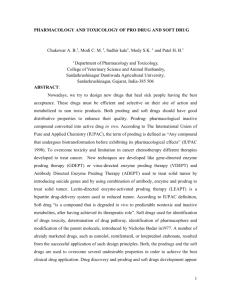Prodrugs II
advertisement
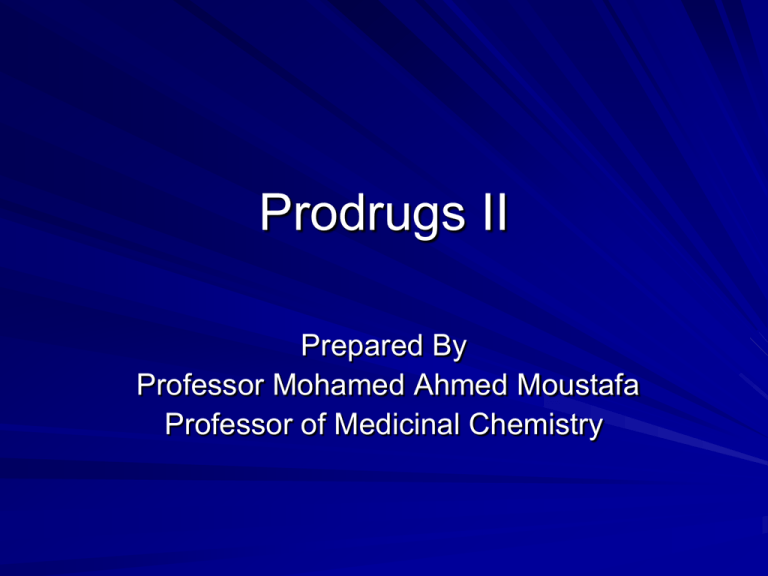
Prodrugs II Prepared By Professor Mohamed Ahmed Moustafa Professor of Medicinal Chemistry DRUG TARGETING Prodrugs for Site Specificity Site-specific drug delivery attempts to obtain very precise and direct effects at the ‘site of action’ without subjecting the rest of the body to significant levels of the active agent. The targeting of drugs for a specific site in the body by conversion to a prodrug is plausible when the physicochemical properties of prodrug are optimal for the target site. It should be kept in mind, however, that when the lipophilicity of a drug is increased, it would improve passive transport of the drug nonspecifically to all tissues. Prodrugs for (increased) Site Specificity To increase the site specificity of certain drugs, the following means of preparing prodrugs are used: 1. Increase or reduction in volume 2. Alteration of hydrophilicity or solubility 3. Introduction or removal of cationic or anionic moieties 4. Change of pKa 5. Incorporation of hydrocarbon or other suitable stable or labile moieties, and carriers that transport the compound to specific organs or tissues and make it to accumulate selectively there, where it is bioactivated. Prodrugs for GIT A nice objective of using prodrugs is to restrict the drug action to the upper part of the GIT If we want to target drugs against an infection of the GIT, then we want to prevent the drugs being absorbed into the blood supply. How?? Retardation of the drug absorption, as in case of sulfathiazole How would you decrease the absorption of this drug? This can easily be done by using a fully ionized molecule which is incapable of crossing cell membranes. The incorporation of strongly hydrophilic moieties to the sulfonamides prevents their transport to the bloodstream. They are incapable of crossing the gut wall and are therefore directed efficiently against the GI infection. Prodrugs for (increased) Site Specificity These prodrugs act almost exclusively inside the intestinal tract. The succinyl or phthalyl group is good enough to decrease lipophilicity of the compound. The hydrophilic group makes the molecule poorly absorbed, preventing its transportation to the circulation. used as intestinal antibacterial agent. O O OH O S O N H N H N S Prodrugs for (increased) Site Specificity Bitolterol, a prodrug of the - O blocker colterol. The toluate groups in both aromatic hydroxyls prevent the methylation of one OH H3C O H3C O NHC(CH3)3 Bitolterol O of the groups by the enzyme COMT, until these groups are removed by hydrolysis by the esterases present in the tissues and in the blood. Esterase Bitolterol accumulates selectively in the COOH lungs, where it partially and immediately OH releases colterol, which stimulate adrenergic receptors and then adenylatic HO NHC(CH3)3 cyclase, with the consequent relaxation of 2 the bronchial smooth muscles. HO CH 3 p-Toluic Acid Colterol Blood-brain barrier (BBB) is one of important membrane often targeted for drug delivery. It is unique lipid-like protective barrier that prevents hydrophilic compounds from entering the brain unless they are actively transported. a The blood brain barrier contains active enzyme systems to protect the CNS even further. ۩ Consequently, molecular size and lipophilicity are often necessary, not sufficient, criteria for gaining entry into the brain. Prodrugs for (increased) Site Specificity Bodor and co-workers have devised a reversible redox ✵ drug delivery system (RRDDS) for getting drugs into the CNS and then, once in, preventing their efflux. The approach is based on the attachment of a hydrophilic drug to a lipophilic carrier (a dihydropyridine) thereby making prodrug that actively transported into the brain. O H R H R X Prodrug residue H X N N CH3 O H CH3 Blood-brain barrier Prodrugs for (increased) Site Specificity Once inside the brain, the lipophilic carrier is converted enzymatically to a highly hydrophilic species (positively charged), which is then enzymatically hydrolyzed back to the drug and N-methylnicotinic acid, which is eliminated from the brain. O H R H X N ♫ The oxidation of the dihydropyridine to CH3 Enzymatic oxidation the pyridinium ion (half-life generally 2050 min) prevents the drug from escaping out of the brain because it becomes charged. ♫ This drives the equilibrium of the lipophilic precursor throughout all of the tissues of the body to favor the brain. O R X N CH3 Prodrugs for (increased) Site Specificity O H R H R X O H H X N N CH3 Prodrug residue CH3 Blood-brain barrier Enzymatic oxidation O HOOC + N CH3 HX Drug R Drug release by a suitable process R X N CH3 Prodrugs for (increased) Site Specificity ♫The functional group on the drug should be an amino, hydroxyl, or carboxyl group. ♫When it is a carboxylic acid, the linkage is an acyloxymethyl ester, which decomposes as in pivampicillin. Prodrugs for (increased) Site Specificity ♫Any oxidation occurring outside of the brain produces a hydrophilic species that can be rapidly eliminated from the body. ♫The released oxidized carrier is relatively nontoxic and easily eliminated from the brain. ♫Although this is a carrier-linked prodrug, it requires enzymatic oxidation to target the drug to the brain. ♫The oxidation reaction is a bioprecursor reaction. Prodrugs for (increased) Site Specificity The brain delivery of -lactam antibiotics for the possible treatment of bacterial meningitis. Since the -lactam antibiotics are hydrophilic, they enter the brain very slowly, but they are actively transported back into the blood. Therefore, they are not as effective in the treatment of brain infections as elsewhere. Bodor and co-workers prepared a variety of penicillin prodrugs attached to the dihydropyridine carrier through various linkers and showed that lactam antibiotics could be delivered in high concentrations into the brain. RRDDS NH2 H N O S N O O O O O N Prodrugs for (increased) Site Specificity Increasing the brain concentration of the inhibitory neurotransmitter aminobutyric acid (GABA) results in anticonvulsant activity. GABA is too polar to cross the blood-brain barrier, so it is not an effective anticonvulsant drug. To increase the lipophilicity of GABA, a series of GABT and -aminobutyric Schiff bases were synthesized. Progabide emerged as an effective lipophilic analog of GABA that crosses the blood-brain barrier, releases GABA inside the brain, and shows anticonvulsant activity. F OH O N NH2 Cl Prodrugs for (increased) Site Specificity 3.The synthesis of a glyceryl lipid (R=linolenoyl) containing one GABA molecule and one vigabatrin molecule, a mechanism-based inactivator of GABA aminotransferase and anticonvulsant drug. This compound inactivates GABA aminotransferase in vitro only if brain esterases are added to cleave the vigabatrin from the glyceryl lipid. It also is 300 times more potent than vigabatrin, in vivo, presumably because of its increased ability to enter the brain. Prodrugs for (increased) Site Specificity D.the application prodrugs to site-specific drug delivery -Glutamyl dopa is an example of a sitespecific prodrug of levodopa (L-dopa). L-dopa is precursor of the neurotransmitter dopamine, which plays an important role in the CNS and also exerts receptor-mediated vasodilation in the kidney. Prodrugs for (increased) Site Specificity Intraperitoneal injection of - glutamyl dopa into mice led to the selective generation of dopamine in HO O OH the kidney as a consequence of the sequential actions of -glutamyl transpeptidase and L-aromatic HO NH amino acid decarboxylase, two enzymes that are highly concentrated in the kidney. The concentration of dopamine in the kidney after -glutamyl dopa administration was five times higher than that after administration of an equivalent dose of L-dopa. O H2 C C O CH NH 2 C C H2 OH Prodrugs for (increased) Site Specificity ► This does occur in a very O O selective manner, suggesting that some N-acyl-glutamylsulfamethoxazole O S O R N H N N H R'HN O derivatives may be useful as specific renal antibacterial agents and -glutamyllevodopa R= OH R' = Acetyl, Butyl N- Acetyl-L--glutamyl-sulfamethoxazole or -glutamyldopamine as specific renal vasodilators. Acetylase Acetate + H 2O L--glutamyl-sulfamethoxazole -glutamyl transpeptidase Sulfamethoxazole + Glutamic acid Prodrugs for (increased) Site Specificity E.Design a prodrug that requires activation by an enzyme found predominantly at the desired site of action. For example, tumor cells contain a higher concentration of phosphatases and amidase than do normal cells. Consequently, a prodrug of a cytotoxic agent could be directed to tumor cells if either of these enzymes were important to the prodrug activation process. Prodrugs for (increased) Site Specificity Diethylstilbestrol diphosphate was originally designed for site-specific delivery of diethylstilbestrol to prostatic carcinoma tissue. In general, though, this tumor-selective approach has not been very successful because the appropriate prodrugs are too polar to reach the enzyme site, the relative enzymatic selectivity is insufficient, and the tumor cell perfusion rate is too poor. designing prodrugs that are activated by enzymes found mainly at the target site. This strategy has been used to design antitumour drugs because tumors contain higher proportions of phosphatases and peptidases than normal tissues. For example, diethylstilboestrol diphosphate (Fosfestrol) has been used to deliver the oestrogen agonist diethylstilboestrol to prostatic carcinomas. C2H5 O HO P O OH C C C2H5 C2H5 O O P OH OH Diethylstilboestrol diphosphate H2O C C C2H5 Diethylstilboestrol e OH Prodrugs for (increased) Site Specificity F.Certain glycosides of antiinflammatory steroids designed to release the parent drugs in the colon. Since drug glycosides are bulkier and generally more hydrophilic than the corresponding drugs, their ability to cross the biological membranes is reduced. Steroid glycosides are not cleaved by the enzymes of the small intestine. In the colon, however, they are hydrolyzed by the bacterial glycosidases, thus liberating the parent drugs in the large intestine. Prodrugs for (increased) Site Specificity G.Two interesting examples are the prodrugs of N- acetylated sulfamethoxazole and of levodopa in which the carrier moieties are glutamic acid derivatives. ►These prodrugs were designed on basis of the finding of a particularly high concentration of an Nacylamino acid deacylase and -glutamyl transpeptidase in the kidneys and that these enzymes would hopefully release the parent drugs in those organs. Mutual OR Reciprocal prodrugs Aspirin + Paracetamol The best aryl ester O is the benorylate, which is a mutual prodrug of Aspirin and Paracetamol. Advantages? O O O O NH Sultamicillin (Self Protection) O NH 2 O S S H N N N O O COOH O COOH Sulbactam (Beta-lactamase inhibitor) Ampicillin O NH2 S H N N O N O C O C O O O O S O Mutual Prodrug (Reciprocal Prodrugs) OH CH3 OPO3Na2 CH3 Sodium phosphate and Carbon dioxide O Cl N Cl O Estermustine Sodium Phosphate Emcyt® - Pharmacia & Upjohn HO Cl NH NH+ClAziridine Cl Nornitrogen mustard Cl Actual alkylating species • Used for metastatic carcinoma of the prostate • Promoiety also a drug! • Prodrug is selectively taken up into estrogen receptor positive cells then urethane linkage is hydroylzed • 17-alphaestradiol slow prostate cell growth • Nornitrogen mustard is a weak alkylating agent Famciclovir is a prodrug of penciclovir which is itself a prodrug Penciclovir is poorly absorbed from the gut owing to its polarity. Famciclovir is less polar and is absorbed more easily. It is then metabolized, mainly in the liver, to form penciclovir which is phosphorylated in virally infected cells. N N AcO N N Liver N HO N NH2 OAc Famciclovir P P P O N NH2 N Viral thymidine kinase OH Penciclovir N N OH N N NH2 Cell kinase P O N N OH N N NH2 Famciclovir O N N N N H2N N N H2N O N HN N N H2N N O HO O HO O HO HO Famciclovir O N HN H 2N P P Penciclovir N O P HO N N Bioprecursors Bioprecursor Prodrugs Bioprecursor” prodrug A compound that is metabolized into an active drug, usually by Phase I reactions; eg acetanilide Do NOT contain a carrier or promoiety Contain latent functionality – Metabolically or chemically transformed into an active – drug Types of activation at are predictable– Oxidative (most common method) Reductive Phosphorylation (antiviral agents) – Non-steroidal antiinflammatory Use: Arthritis Oxidation Example – Nabumetone – Relafen® – Smith Kline Beecham O Series of oxidative OH CH3 CH3 O decarboxylation CH 3O O Active form of the drug that inhibits Prostaglandin biosynthesis by cyclooxygenase Bioprecursor Prodrugs Reduction example - Mitomycin C - Mutamycin® - Bristol Adenocarcinoma of the stomach and Myers pancreas H 2N H 2N OH CH3 O H2N O H 2N O O O OHH O O H OMe ReductionH2N OMe -OCH3 H2N NH NH NH N N CH3 CH3 +N OH A quinone electron withdrawing A hydroquinone electron donating -H+ H+ OH NH Further alkylation H2N DNA H2N H2N N CH3 OH OH DNA -CO 2 N CH3 + OH Electrophile NH -NH3 OH O O H 2N N CH3 OH NH Examples - Bioprecursor Minoxidil is an antihypertensive that is also used as to prevent hair loss (Rogaine/Regaine) The active constituent is a Phase II metabolite, minoxidil sulfate H 2N O N NH 2 H 2N OSO 3 N NH 2 Phase II metabolism N minoxidil N minoxidil sulfate Pilocarpine Bioprecurses N O OR HO N Invivo N O OR O N N O O N R = Ethyl, Butyl, Benzyl, OR others b) Sulfoxide Reduction The antiarthritis drug sulindac is an indene isoster of indomethacin, which originally was designed as a serotonin analog. Sulindac is a prodrug for Sulindac sulfide, the metabolitc reductive product CH2COOH F CH3 H O R= R S CH3 S CH3 O S CH3 O N-Oxidation N-Oxidation prodrug activation reaction is the reversible redox drug delivery strategy for getting drugs into the brain. In case of N-Methylpyridinium-2carbaldoxime chloride (2-PAM) is used as an antidote to poisoning with cholinesterase inhibitors. Because of its charge and hydrophilicity it does not penetrate the blood-brain barrier. C H N CH3 2-PAM NOH .Cl Pro-2-PAM Pro-2-PAM , the reduced dihydropyridine form of 2-PAM, readily enters she central nervous system. C H N CH3 NOH .Cl 2-PAM There it is oxidized to form 2PAM, which remains trapped in the CNS since its charge reduces its rate of transfer from the brain back into the blood. N C H CH3 Pro-2-PAM NOH Bioprecursor Prodrugs HN O HO O O Phosphorylation example – I HN O O OPO O O- Viral Thymidine Kinase OH Iodoxuridine - Herplex® Allergan - lipid soluble! Opthalmic product for Herpes simplex keratitis Higher affininty for viral kinases than mammalian kinases but some toxicity O I Not lipid soluble OH ATP -O HN O O O O P -O P -O P -O O O O O O I OH TWO mechanisms of action: 1. Inhibits DNA polymerase 2. Incorporated into DNA affording incorrect base pairing and template activity Chemical Delivery Systems We have already seen 2 examples of this: – Sulfasalazine – an azo compound – Methenamine – An urinary antibacterial agent Requirements – Prodrug reach the site of action in high concentrations – Knowledge of high metabolism at site – Other factors Extent of organ or site perfusion Information on the rate of prodrug conversion to the active form at both target and non-target sites Rate of input/output of prodrug from the target site Limit side effects and increase effectiveness
